Printable Affidavit of Residency Document for Texas
The Texas Affidavit of Residency form is a legal document that verifies a person's residence in Texas. This form is often required for various purposes, including enrolling in schools or obtaining certain benefits. It is crucial to complete this form accurately to ensure compliance with state requirements.
Take action now by filling out the form. Click the button below to get started.
Access Editor
